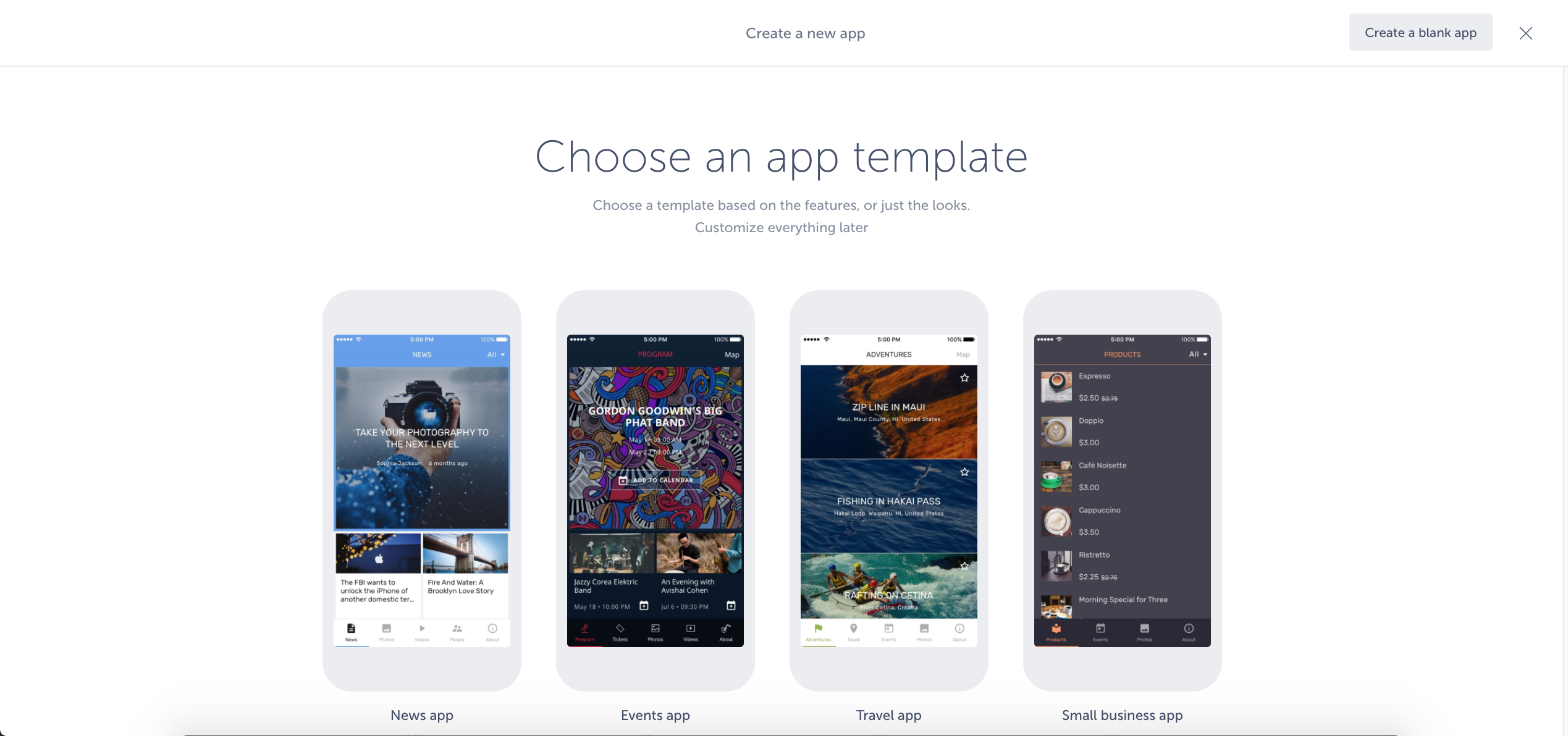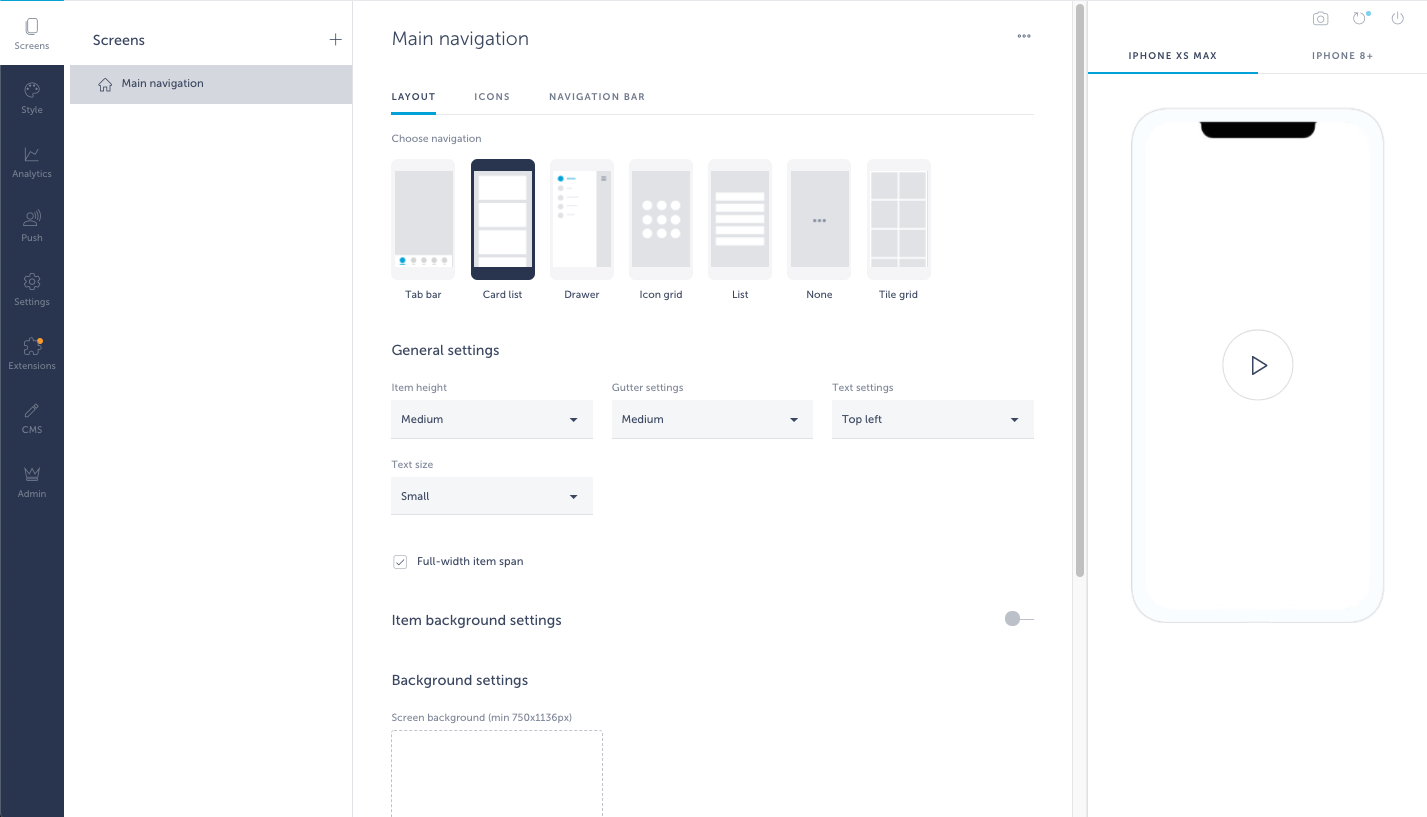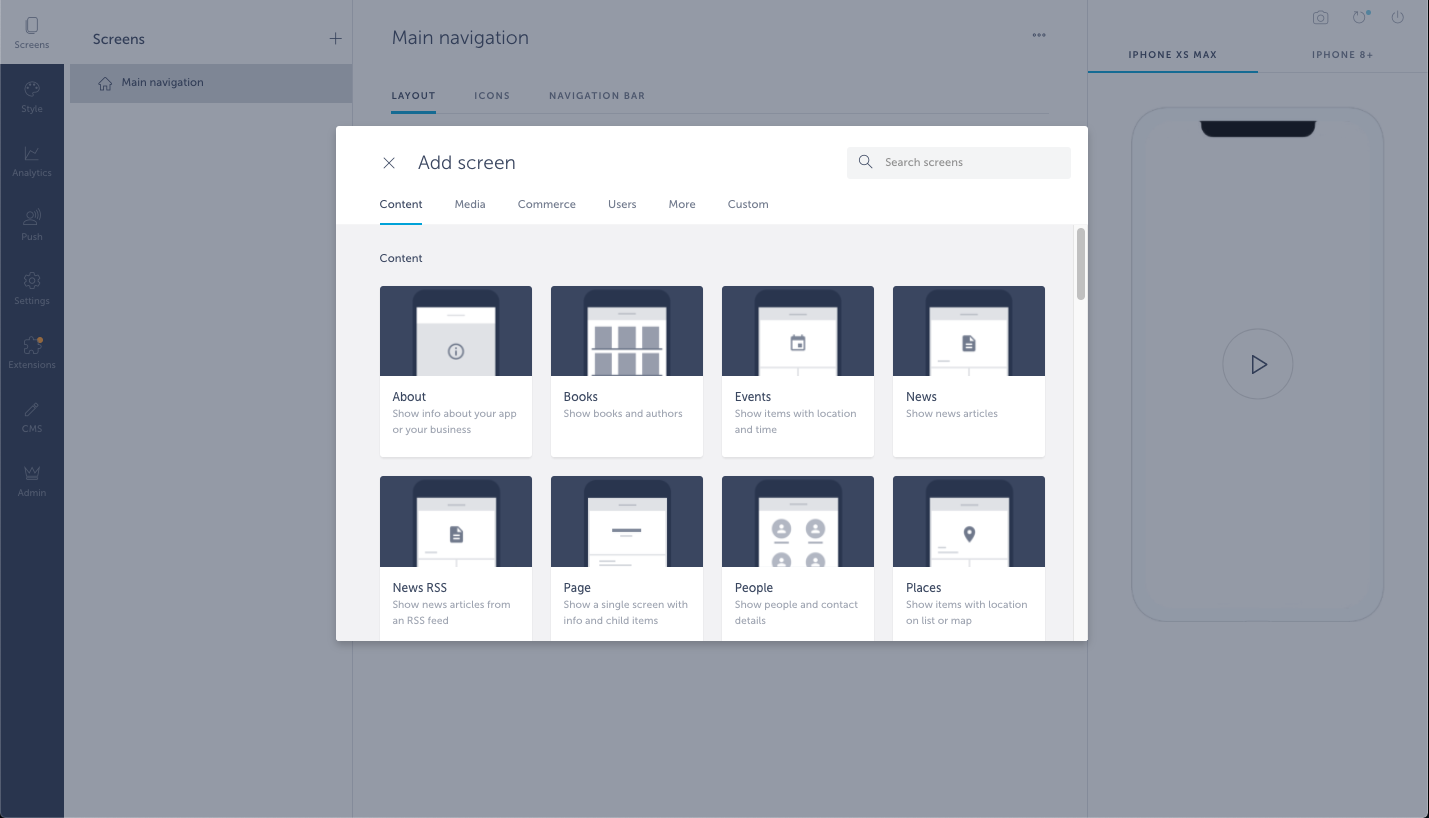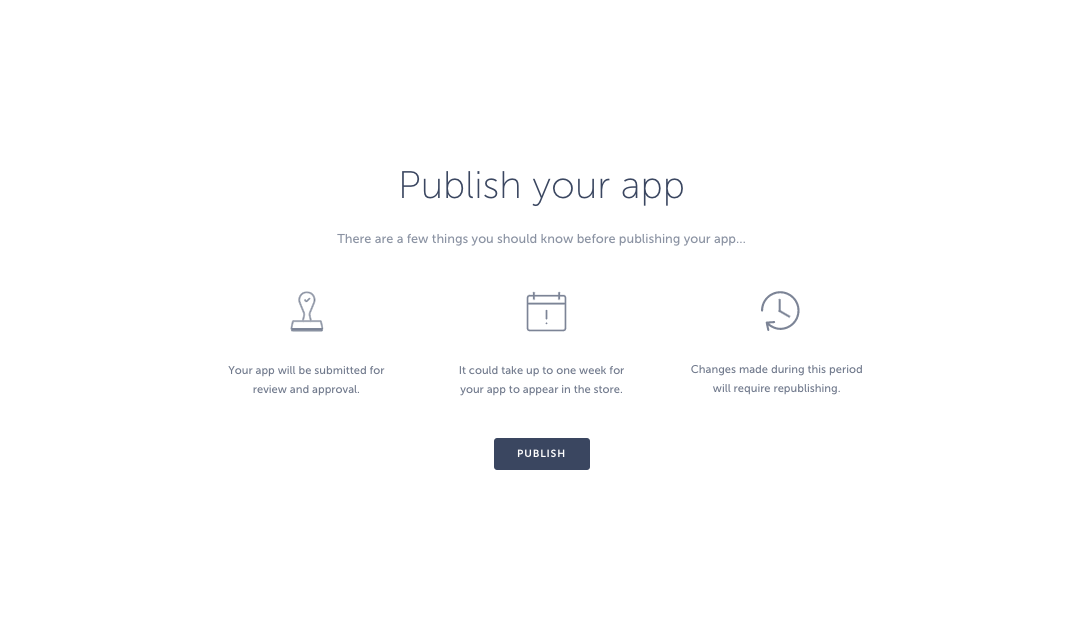how to design an app without coding
Making an Android mobile app from scratch isn't easy, especially if you don't use a mobile app builder. There are lots to do. First, you need to prepare all your ideas for your mobile app: its name, visual feel, content, and any other details you may need. Then, after lots of revisions and iterations, after you cement all of those details, you're ready to start building your app. To help get you started — and save you time and money spent on app development — we created a guide on how to make an app without any coding knowledge at all. Here are our tips and tricks.
Apps for Android
If you have an app idea but aren't sure how to realize it, follow these steps to create your Android app as quickly as possible.
Why do businesses build mobile apps? What's wrong with a website? Well-designed apps with intuitive user experiences out-perform traditional websites with their portability and speed; apps store data locally instead of remotely like on a website.
Check out these Google Play statistics on why you and your business should have an app:
- Google Play generates the largest amount of worldwide app downloads. In 2020, app users downloaded 108.5 billion apps from Google Play
- There are 1.6 billion active Android users
- Android is maintaining its position as the leading mobile operating system worldwide by controlling the mobile OS market with an 85% market share
- There are more than 5 million apps in the Google Play Store
- Mobile apps are projected to hit $581.9 billion in revenue in 2020
- Since the covid lockdown in late March, global app time-usage on Android devices reached nearly 70 billion hours per week, 25% above the weekly average for H2 2019
Did you know the average Android user spends 3 hours and 40 minutes using mobile apps per day? This is a 35% global increase in mobile app usage compared between 2017 and 2019. Chances are your users will look at your app many times per day and enter your app even if they don't engage with it. The main takeaway here is that even if your users don't actively use any given app on their phones, they'll still see your brand or logo multiple times throughout their day. Don't miss out on this kind of mobile advertising with Shoutem's mobile app builder.
I have an app idea, where do I start?
There are 4 things you should consider before making a mobile app for Android
Start thinking about your overall goals and strategies and how creating an Android mobile app would benefit your business.
1. Market research for no-code app development
When you're starting something new and realizing your vision, study the market to find out what products are already out there, similar or opposite to your idea. Make sure to download several apps to get a sense of what your potential users are expecting — this is critical research for your business' app.
Keep a level head about your app. Everyone thinks that their mobile app will dominate the Google Play Store charts instantly. The reality is that approximately 8,000 Android apps are launched on the Store every day, with the majority failing shortly after release.
When you're ready to research the good and the bad on the market, it's necessary to:
- Study similar mobile apps related to your business
- Determine what functionalities are necessary for such an application
- Research your competitors and their mobile strategies
- Read reviews of applications in your niche. Here you can find what works and doesn't work from users' perspectives for creating your no-code mobile app
- Understand Strengths, Weaknesses, Opportunities & Threats. Do a SWOT analysis of your business and competitors to inform your next steps
2. Defining app functionality before using the mobile app builder
We know we already mentioned this, but it deserves its separate step. When you audit your competitors' apps, write down what functionalities they have, and determine how important each one is for your application.
Each application has its own import. It is necessary to understand what value your application would contribute to the market and its purpose: what problem(s) does it solve for users?
To execute this step correctly, answer these questions:
- What is the main purpose of the application?
- What functionality is at the core of the application?
- What value does an application give to your business that a website doesn't?
- What functionality will users have with your app that isn't in other apps or on your website?
Also, don't forget to check what would be the best mobile app maker online!
3. Native app vs. hybrid app vs. web apps
Here's a quick explanation of the different technologies you can use.
A native app, or a native application, is a software application built in a specific programming language for a particular device platform, like iOS or Android.
Native iOS apps are written in Swift or Objective-C. Native Android apps are written in Java.
Pros: Fast and responsive; easy to tap into wider device functionality; matches apps<br>UI/UX to platform conventions. Cons: You need more than one codebase; native apps cost more and take longer to build. Hybrid apps can be installed like native apps, but they are actually web apps inside.
Like web apps, hybrid apps are built with Javascript, HTML, and CSS. They run in something called web view, which is a simplified browser within the app.
Pros: Only one database to manage; save time and money on development; easier to scale with access to device features. Cons: Performance issues because they load in a browser-like component; limited UX. Web apps, also called Progressive Web Apps (PWA), need to be distinguished from websites. Web apps are websites designed fluidly; they respond to being viewed on a mobile device and function like downloadable apps but from your phone browser.
Pros: In-browser functionality (they don't need to be downloaded or installed); update automatically; don't require app store approval so can be launched quickly. Cons: Slower than mobile apps; fewer features; very hard to discover because they are not listed in app stores; less than ideal security. 4. App Monetization
Mobile apps can dramatically affect your overall business and are most often created to generate additional earnings or improve a brand's user experience. Mobile apps can also serve as brand awareness tools or as a step in your overall sales funnel.
For example, you could have a loyalty app where users can get different coupons, learn about promotions, collect rewards points, or earn discounts.
If you plan to use your app as a monetization tool, you need to consider what model would best suit your business. Here are the most common models:
- Freemium apps
These apps are free to download, but users need to pay to unlock some features and content - Premium apps
Users are required to purchase these apps. If you want to use this monetization model, consider undertaking a more substantial marketing strategy because your users will need to pay for your product without knowing what's "inside" of it - In-app purchases
If you are planning to sell products with your app, this model will suit your business best - Subscriptions
Similar to freemium apps, your users need to pay a (monthly or yearly) subscription for some features or content - In-app ads
This type is most common. Your users don't pay to use your app. Simply provide advertising space within your mobile app without sacrificing user experience - Sponsorship
After attaining a large user base, you could partner-up with brands and advertisers. This arrangement is a win-win because brands pay for users' actions, and your app generates user engagement
Hooray! So you decided to build your app by yourself with Shoutem's mobile app builder. Let's go through the steps you need to take to create your Android mobile app. Or if already know what to do, build now!
If you want to create an Android AND iOS app, all the steps are almost the same for building an either app with Shoutem.
Build your codeless Android mobile app in just 6 steps
1. Go to the builder and build a blank app, or pick one of our templates
If you want a mobile app for news, events, travel, and small businesses, or to showcase your products or even an app for school, use one of our templates — feature-rich to save you time. If you choose a template, you can still change your app's theme and navigation. Because you'll already have the needed features with templates and only have to change the content, you can skip step 5 to Add Content to Your App or go to step 4 if you want to change some features.
Before starting with those steps, perhaps take a look at one of our full guides for no-code app creations:
– MVP – What is Minimum Viable Product and Why Is it Important
– App Design in 2021
– App Logo Creation
– Radio App Making
– Church App Maker

Below you'll find the steps for building your first Android mobile app. First, pick a name, and give your app a title. For templates, try one of these:
- Loyalty and Deals
- Radio app
- Sports app
- Business to Business app
- Business to Customers app
- Tourism and Recreation app
- Apps for Ministries and Churches
- Apps for Schools and Universities
- Shop and M-commerce
- Assisted Living Apps for Senior Homes
- TV Channels Apps
- News apps
When you enter the builder, you can choose between seven different navigation styles. The navigation styles will define your mobile app's first look because here your customers will be able to see all of your app's features. You can modify your navigation, item height, text settings, background images, etc.

Choose the icons you want your features to have. Placing icons next to your text or features increases your mobile app's readability, and they give a visual representation of what's written, making your app memorable and eye-catching. Icons make the text easier and faster to consume.
With different features, you'll find many that are commonly used, like a location icon with the Places feature; each icon can be personalized and changed.
For the Navigational Bar, choose a background image that will always be displayed (you can change that, too). The best practice is to use an image with your logo or brand name.
3. Modify Your App's Theme with Shoutem's App Creator
Here you can change your app's colors! Yay! You can choose between four existing themes: Prime, Bleu, Noir, and Rose, but if you want to play around a bit, you have options:
In the Basic Colors section, you can change
- Featured color
- Background color
- Paper background color
- Shadow color
Navigation Bar (header)
- Notch status bar color
- Title
- Icon color
- Title color for featured layouts
- Icon color for featured layouts
- Background color
- Header bottom border color
Tab Bar and Drawer Layouts
- Background color
- Item text and icons color
- Tab Bar border color
- Item background color
- Selected item text and icon color
- Selected item background color
- Tab Bar selected item border color
For Typography, you can change:
- Heading
- Title
- Subtitle
- Caption
- Text
- Buttons
Overlays:
- Default overlay color
- Default overlay text and icon color
- Image overlay text and icon color
… and much more.
To understand these options better, here is a showcase and manual on how to change each. After you chose what colors and styles you want to have, it's time to add extensions that your customers will enjoy.
4. Add Your Favorite Features without a single line of code
All Shoutem features are basically developed as extensions. If you have News, Photos, or Analytics features in your app, they are extensions. The Shoutem app dashboard comes with some basic extensions installed that are immediately available for use.
Features are divided into sections. For better readability, so you can see Content features, Media features, Commerce, Users, More, and Custom.

Also, third–party extensions are available so you can implement your own extensions. You can write an extension yourself or (coming soon!) purchase and find free extensions in our Extension Marketplace.
Click Extensions (the left sidebar) to access the Marketplace. Here you'll see a list of the extensions you already have installed. Need a manual or tutorial? Here it is: Install Extensions on Your App.
5. Add Content to Your Android App
Adding content is as easy as it gets with Shoutem. Here is a great video tutorial on adding content to your app (it'll save you time reading and typing).
(the builder is slightly different now, but the functionality remains the same)
6. Publish Your App
Before clicking on that blue Publish button, there's one more section to read before your app is store-ready: App info (the app's name and Store metadata section).
The Store metadata section is where you enter your app's information required to publish on the Google Play Store. It's critical to have the Developer info section completed to ensure timely delivery during the publishing process. We also prepared a manual on how to do that.
You can also download the Shoutem Preview App for Android so you can see on your phone how your app looks before publishing.

After clicking the Publish button, our publishing team automatically receives your publishing request, and we prepare each app for publishing manually. If all the pieces of information are populated in the Google Play Store metadata tab, the app will be published (manually as well), but if something's missing, you'll be notified.
Ready to build your own mobile app?
Google Play Store app optimization
An app's success in either app store depends upon knowing the differences in each market's algorithms.
The first crucial thing for the optimization of your app for the Google Play Store is to provide the app's metadata. Setting this helps your app's visibility and helps your app get discovered on Google Play.
The main ranking factors for Google Play and the App Store are:
- App icon: Focus on creating something eye-catching and well-suited to other industry standards within your app's genre.
- App name/title: Your app's title is one of the strongest ranking factors in either app store, so it's best to include the most relevant keywords as your ASO starting point.
- Visuals and video: Screenshots and videos placed in both stores should represent the app's main features. Best practices dictate that your screenshots must tell a story.
- Short and long description: Write what your mobile app is about to help both search engines and users understand your app's functionality and purpose.
There is also a Long Description that matters. If you're thinking about creating both an iOS and Android app, read about the Differences between App Store Optimization on Google Play vs. App Store.
Marketing was always and still is a crucial segment of every business. Mobile apps are no exception. It's predicted that advertisers will pour more than $290 billion into ad spends in 2021, and was $204 in 2020! Because of this, we implemented AdMob into Shoutem. This is a year of massive mobile advertising because brands continue to embrace mobile's unprecedented reach and value.
What are some small steps you can take to improve your visibility?
We realized that many apps in Google Play Store don't have tags, while many of them have keywords at the Apple App Store. That was a bit odd, and we wrote a small guide on how to choose the most fitting category for your app, as well as the relevant tags for your app.
*Tags help app store visitors to filter and find what they need without any struggle and endless scrolling.
One thing never-ending is definitely app store optimization. Checking up metadata, competition, and their keywords, updating app description according to trends, etc. Don't forget about your app once you publish it. Check more on ASO for Google Play and Apple App Store.
In case you are just starting with your app promotion and marketing activities, take a look at our beginner-friendly Mobile App Marketing Guide that goes through each marketing process phase. It's a step-by-step guide covering the basics of mobile app marketing so that you have the tools and know-how to reach your target audience and turn that audience into active app users.
For the bold ones who want to take care of their business, while experts take care of their app, we created the Growth package, where top-notch growth specialist takes care of:
- App strategy for accelerated growth
- Measuring an app's performance
- App launch strategy
- App Store Optimization (ASO)
Schedule a free call and let's see how can we hit the charts together.
FAQ for developing an Android mobile app
- How much does it cost to build an Android app?
With Shoutem, if you want to build an Android app, it will cost you $59/month for annual billing (or $79/month in case you want to pay month after month). In case you want your app to live long and prosperous, go with a yearly plan and get three months for free and save $240!
- How much time do I need to build an Android app?
It depends on how many features you need and how much content you will enter. Usually, it would be best to have one working day to manage functionalities and enter content. So, yes, you can do it all in one day!
- Can I create an app all by myself?
Yes! We created our builder so only one person — without any coding knowledge — can build an Android mobile app.
- Is Shoutem Turnkey App Platform?
Yep! You can choose from existing templates and features to kick-start your app development. No coding skills are required.
- I like your platform, but I have no time. Do you provide app development service?
Tell us about your dreams, and we'll make them a reality. While you take care of your business, we will design, build, publish, and manage your app – 24/7! Check out our Shoutem Pro service and see what are the options.
Ready to build your own mobile app?
Time-poor, no more. Let us build your app within a week
You find it hard to manipulate with mobile blocks and that's completely fine. Take care of your app while we take care of your mobile app.
Shoutem Pro is a service we designed for business owners who needs their app fast and wallet-friendly.
Get app design, features setup, and content import. Your business. Your goals. Your mobile app. Give us a call, and let's hit the charts together.
how to design an app without coding
Source: https://shoutem.com/blog/how-to-create-an-android-mobile-app-without-coding/
Posted by: sublettandere.blogspot.com

0 Response to "how to design an app without coding"
Post a Comment